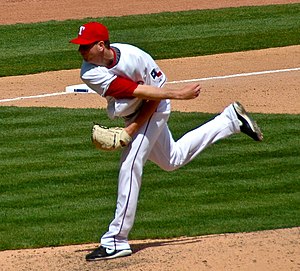 Texas Medical Center (Photo credit: slight clutter)
Texas Medical Center (Photo credit: slight clutter) Image via Wikipedia
Image via Wikipedia Image via Wikipedia
Image via Wikipedia Image by Getty Images via @daylife
Image by Getty Images via @daylife Image via Wikipedia
Image via Wikipedia Image by Getty Images via @daylife
Image by Getty Images via @daylife{Verbatim with permission from Jamey Newberg's Newsletter}The two outfielders walked together toward the most remote station of the most remote campus of the most remote spring training complex in Arizona, 1900 miles from their Georgia homes, towns with populations that amount to less than 30 cents on the Surprise dollar.
Jordan Akins and Zach Cone are prime examples of why baseball takes time.
On the recommendations of Georgia area scout Ryan Coe, Texas made Akins the 103rd player selected in the 2010 draft (round three) and Cone the 37th pick (supplemental first round) in 2011. Cone, the University of Georgia product, struggled in his rookie season, hitting .201/.278/.339 (57 strikeouts in 224 at-bats) for Short-Season A Spokane last summer, but he wasn't anywhere near as unproductive as Akins, the high school grad, had been in his debut the year before, when he hit an empty .187/.241/.252 (35 strikeouts in 107 at-bats) for the Rookie-level Arizona League squad.
A year later, there might be fewer than half a dozen prospects in the Rangers system who have flashed more upside offensively than Akins. The show he put on in Fall Instructs late last year, after an encouraging .283/.312/.428 encore in the Arizona League, caused me to write glowingly, even on a Newberg scale. If I were another team dangling an impact player that Texas was chasing, Akins would be a guy I'd push very hard for on at the back of the deal.
If we were to decide a ballplayer's future based on a rookie season alone, we'd have written Akins off a year ago.
That's not to say that Cone is half a year away from forcing fans to debate whether he should be untouchable. He may never make it to AA.
But this is a game of failure, and adjusting to failure, diminishing its impact, and minimizing its endurance. Those who adjust at a more accomplished pace than the players 60 feet and six inches away advance; those who don't, don't.
Cone didn't get any good wood in his live BP session against righthander Ben Henry, who in five pro seasons hasn't moved past Low Class A, or against righty Ken Wiser, the 51st and final player drafted by Texas in 2011, but neither did Akins against either Wiser or righthander Francisco Mendoza, whose four seasons have topped out a Low Class A as well. You can't tell a whole lot in a sampling of BP sessions (says the fan blogger who's never afraid to drop 1,000 words on a player who had a good half-hour at Fall Instructs), and I wouldn't suggest any conclusion can possibly be drawn when sidewinding 26-year-old lefthander Kyle Fernandes makes 16-year-old Nomar Mazara look lost at the plate in a two-minute duel, just as I wouldn't make too much of the fact that Alexi Ogando, Greg Reynolds, Tanner Scheppers, Wilmer Font, and Robbie Ross each took a pitching machine deep late Monday morning, though people far smarter about these things than I am will confirm that, regardless of who's pitching, Rougned Odor just hits.
The overriding point I'm trying to make, without meaning to diminish the value of the experience of watching Christian Villanueva field or Miguel De Los Santos pull the string or Hanser Alberto hit or Jurickson Profar do everything, is that things can change, sometimes relatively quickly and other times only after the impatient set has tuned out. This isn't football and it isn't basketball, and the payoff of bringing a kid like Jorge Alfaro or Neil Ramirez into the system is typically not realized for years, if at all.
Two of the most aggressive talent accumulators in the game, Tampa Bay and Texas, signed Cuban first baseman Jose Julio Ruiz in 2010 and 2011, respectively, each building in multi-year, multi-million-dollar options that they hoped he would give them little choice but to pay with his minor league play. He didn't, and neither did they.
Last week, Ruiz signed with the Laredo Lemurs of the independent American Association, a move that we can assume one party to that negotiation is very happy about. He'll be 27 in two weeks, and right there is all the reason you'd need to understand why his opportunities with the Rays and Rangers were structured without factoring in any room for patience.
Players rarely come to Major (or Minor) League Baseball at such an advanced age. Usually those who do are Cuban defectors or Pacific Rim stars. Most aren't Yu Darvish, but when they're Jose Julio Ruiz, they become Laredo Lemurs after just seven months in the minor leagues.
The other 99 percent of players who leave home to give baseball a shot, particularly those blessed with elite athleticism and the baseball promise that in keen cases attaches to it, typically earn years of patience, a relative rarity in pro sports and often a challenge in being a fan of pro sports.
As 22-year-old Zach Cone and 19-year-old Jordan Akins walked into a cage to get locked in before stepping in for live BP on Field 5, in the deep recesses of a baseball facility expansive enough to have a Field 5, one a major college product who struggled in his first effort to play pro ball, the other a raw high school product three years his junior whose initial struggles were even greater but who now builds off an unmistakable breakout year as an athlete-turned-ballplayer that promises more, both a long way from home and setting out on a long path to where they want to be, it was an ordinary moment early in minor league camp that nonetheless serves as a reminder that restlessness will not only spoil the time-tested formula for building a baseball franchise with any sort of staying power -- it's also a recipe for disappointment if you're a fan.
Click here for more articles by the Gold Standard for Team Bloggers: Jamey Newberg for The Rangers.

No comments:
Post a Comment